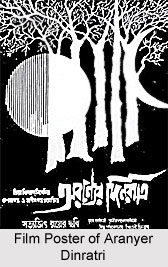 Set in the 20th century background of the post Independence era, the novel Aranyer Dinratri represents the confrontation of the urban sophistication with rural simplicity. The falsity of the city-bred in the post Independence panorama, which is more accurately discernible when confronted with rural spontaneity is the principal theme, with which the novel, Aranyer Dinratri deals. The novel Aranyer Dinratri, depicts the moral predicament of the city bred, bereft of emotional attachment to the fellow beings. Cease to exist as a rational being, the metropolitans only subsist to pacify the material needs. Aranyer Dinratri portrays the escapism of four individuals in the lap of nature, being exhausted by the daily grinding of the city.
Set in the 20th century background of the post Independence era, the novel Aranyer Dinratri represents the confrontation of the urban sophistication with rural simplicity. The falsity of the city-bred in the post Independence panorama, which is more accurately discernible when confronted with rural spontaneity is the principal theme, with which the novel, Aranyer Dinratri deals. The novel Aranyer Dinratri, depicts the moral predicament of the city bred, bereft of emotional attachment to the fellow beings. Cease to exist as a rational being, the metropolitans only subsist to pacify the material needs. Aranyer Dinratri portrays the escapism of four individuals in the lap of nature, being exhausted by the daily grinding of the city.
Author:
One of the important luminaries of the modern Literature Sunil Gangopadhya was born in 7th September 1934 in the village of Maichpara of Faridpur district, presently in Bangladesh. The most prolific and effervescent writer of the modern Literature, Sunil Gangopadhya was socially conscious. He has a profound experience of the cross currents of the socio-intellectual life of modern Bengal. Endowed with his personal experience, his novels are the magnum opus of a variety of human condition scattered in the different stratum of society. The intricacy and the spiritual aridity of the human mind, which is the sole cause of the social evil is the chief subject he is concerned with. Unlike his predecessors, the principal subject of his works is the individual living in the society rather the abstract society itself.
Synopsis:
Based on the socio-intellectual arena of post Independence period, Aranyer Dinratri is the tale of four city-bred friends sharing different perspective.
 The story opens with four friends, being tired of the chaos of the city life, venture out to the forest of Palamau for a holiday excursion in car. Set out unknowingly for their destination, they arrive in a small village and somehow manage a guesthouse, by bribing the caretaker. The storyline of Aranyer Dinratri develops with the respective reactions of these four friends to a series of minor events relating to the new environment. Four young men, full of haughty arrogance and pretentious respect to the unsophisticated rustic is the key subject of Aranyer Dinratri. In a more subtle way Aranyer Dinratri is the story of self-exploration of Ashim (the richest of the four), Sanjoy (the timid person, who always play safe), Hari (the non-intellectual Sportsman) and Shekhar (the self confident and comical).
The story opens with four friends, being tired of the chaos of the city life, venture out to the forest of Palamau for a holiday excursion in car. Set out unknowingly for their destination, they arrive in a small village and somehow manage a guesthouse, by bribing the caretaker. The storyline of Aranyer Dinratri develops with the respective reactions of these four friends to a series of minor events relating to the new environment. Four young men, full of haughty arrogance and pretentious respect to the unsophisticated rustic is the key subject of Aranyer Dinratri. In a more subtle way Aranyer Dinratri is the story of self-exploration of Ashim (the richest of the four), Sanjoy (the timid person, who always play safe), Hari (the non-intellectual Sportsman) and Shekhar (the self confident and comical).
Aranyer Dinratri is a detailed psychological probing of the city bred individuals represented by four friends in their individual response to the drunken spree, social embarrassments, adventures with servants, officials and romance. The sterile psyche of the urban individuals epitomized in the attempt of Hari to make love with Duli, a tribal woman being refused by Atasi. Sanjay is the replica of a modern escapist, who does not dare to respond to Jaya`s bold seduction. Rationality is portrayed only through Asim-Aparna episode. Finally the friends again depart for their native destination Kolkata, with a better appreciation of their own psyche. Aranyer Dinratri delineates the confrontation of rationality with impulsive imprudence. The conflict between the rationality and imprudence, sophistication with simplicity makes Aranyer Dinratri as a psychological study of self-exploration.
Aranyer Dinratri deals with the sojourn of the four friends in a forest caped tribal land of Palamau. The title truly signifies the subject with which the novel is concerned. The experience and the particular reactions of the different individuals during their days in forest, which ultimately ends in their self-revelation is the key message of Aranyer Dinratri. The title, "Aranyer Dinratri", an analytic one describes the essence of the novel, which is the psychic study of individual in an unfamiliar situation but in a familiar premise.



















